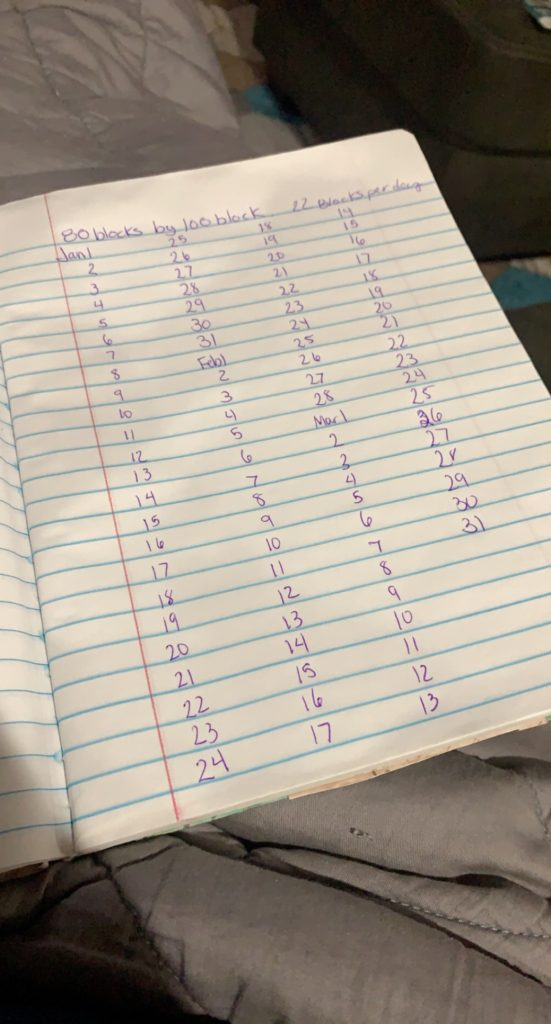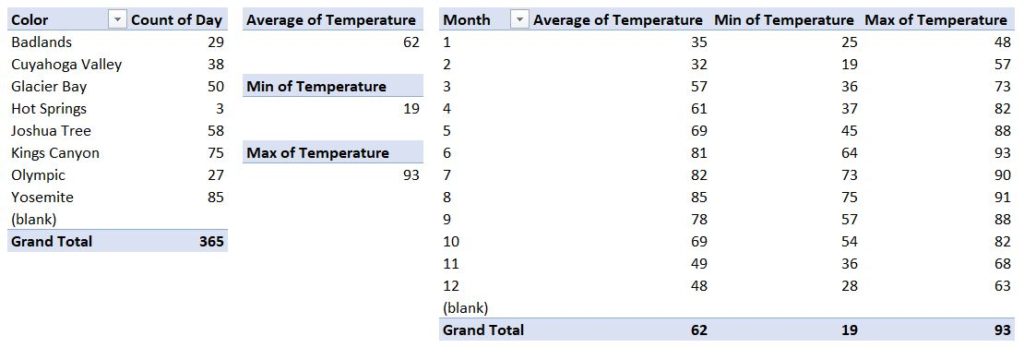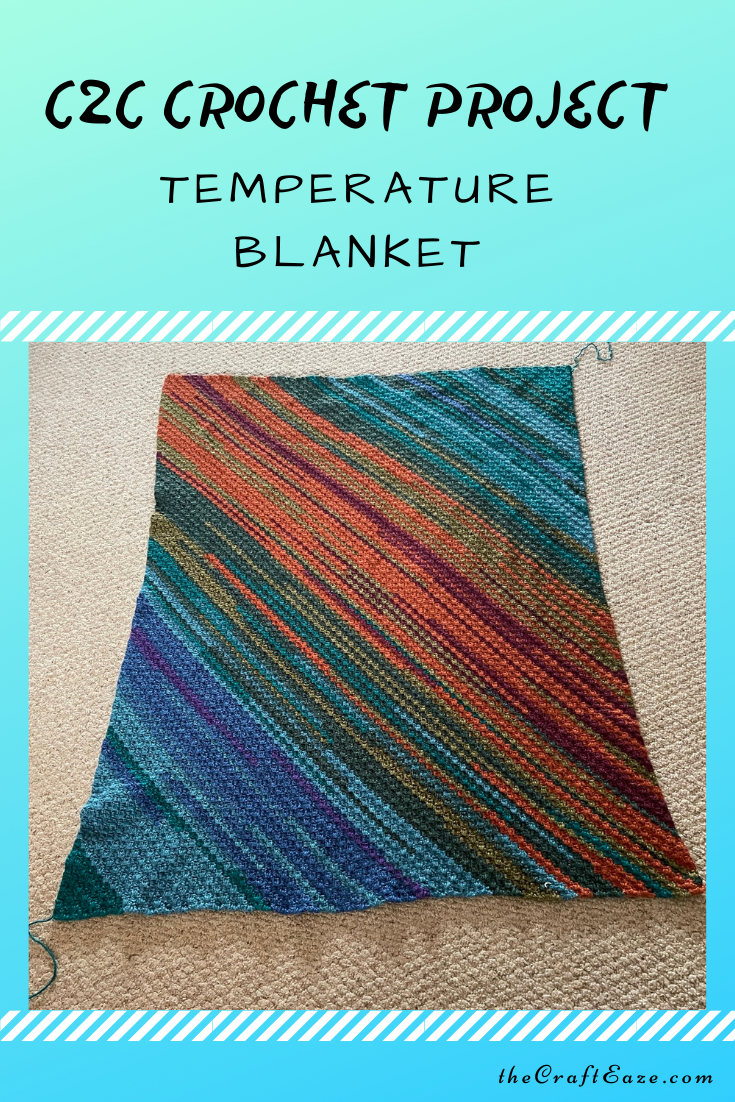Some links posted below may be affiliate links which means I’ll earn a tiny commission if you purchase through them.
On December 31, 2020, I decided that 2021 was going to be the year that I would attempt a temperature blanket. Little did I know that 2021 was going to be a crazy year for my husband and me. We had many ups and downs this year, but I am proud of myself for finishing it. Between weddings (we went to 8 I believe), trips (Grand Canyon, Key West, Gulf Shores, and back home to Missouri), family, work, and both of my husband and me having COVID our 2021 was extremely busy.
I am very excited to share my temperature blanket project. I used a corner 2 corner pattern for my temperature blanket. What I liked about using a corner-to-corner pattern for this project, I was able to control the size of my blanket a little more. I was afraid that if I did a traditional temperature blanket with 365 rows, it might not be proportioned well. I also picked a more muted color palette because I wanted the blanket to match more of my style since I was going to display it in my living room once completed.
Color Palette And Pattern Development

For my color palette, I used the Lion Brand Heartland yarn. I love this yarn. It comes in a variety of different colors and is very soft. Each color is named after a National Park. This yarn combines two of my interests – crocheting and visiting national parks. Below are the temperature ranges and colors that I used for my blanket. You can buy the yarn at both Michaels and Joann Fabrics. The temperature ranges worked very well for Northeast Ohio.
- 22F and below – Hot Springs (Purple) – Joann Fabrics
- 23F-32F – Olympic (Dark Blue) – Joann Fabrics – Michaels
- 33F-43F – Glacier Bay (Light Blue) – Joann Fabrics – Michaels
- 44F-53F – Cuyahoga Valley (Blue/Green) – Michaels
- 54F-66F – Kings Canyon (Green) – Joann Fabrics – Michaels
- 67F-77F – Joshua Tree (Yelow/Green) – Joann Fabrics – Michaels
- 78F-87F – Yosemite (Orange) – Joann Fabrics – Michaels
- 88F and above – Badlands (Red) – Joann Fabrics
So for my temperature blanket, I knew I wanted to do a pattern that would allow me to have more control over the size of the blanket. I decided to do a corner two corner pattern and would do a specific number of squares/blocks each day. But I first had to determine what size to make my blanket and what hook to use. I decided to use G/6 4.25 mm crochet hook. Based on past projects, I knew that 1 block using this hook is approximately 0.5″. I determined that I wanted my blanket to be 80 blocks wide and 100 blocks long. This would give me a blanket that was close to 4 ft by 5 ft. I feel that 4 ft by 5 ft is the perfect size for a blanket.
So the next step was to determine how many blocks I would need to make a day. My blanket will contain 8,000 blocks (80×100=8000). 8000 blocks/365 days is equal to 21.9 blocks per day. So I rounded this up to be 22 blocks per day, but I also needed a small correction since I rounded that needed to be accounted for since I had an extra 30 blocks to account for. So to make it easy, I picked 15 days where I would only make 20 blocks instead of 22 blocks. I scattered these 15 days around the year.
I put the high temperature of each day into a notebook. For my blanket, I used the time and date website to determine the high for each day. This way my temperatures came from the same source each day. The days that were going to have 20 blocks were indicated by a smiley face symbol. I also put a star symbol by the days where the blanket was at its widest point and longest point.

Then I was ready to start my blanket. If you are not familiar with corner to corner, you should check out this post from Make and Do Crew which goes over the process. I found this post very helpful when I made my first corner to corner project.
Fun Facts About My Temperature Blanket
I found it fascinating was that I start and ended the year with the same color (Cuyahoga Valley) which is also the park that is closest to my house. It seems so perfect that Cuyahoga Valley was the first and last color of the year.
Because I am an engineer in my day job, I love data. So I decided to put all of my temperature data into Excel (I would normally use JMP, but that is on my work laptop which is in the other room). The average high temperature for the year was 62F. 2021 had a min temperature of 19 and a high temperature of 93. The least popular color was Hot Springs. The most popular color was Yosemite.

I also took a picture at the end of every month. This really showed the progress through the year. I then made a TikTok video showing the blanket throughout the year. When I looked at the temperature blanket like this, I am amazed by how much the temperature changed each month.
All in all, I enjoyed making my temperature blanket even if it did get monotonous at times. It is amazing how the temperature changes throughout the year, but I don’t think I will make another one of these for a few years. It took up a lot of space on our couch between the unfinished blanket and the many skeins of yarn. I highly recommend that you try a temperature blanket this year!


So at what number day did you start decreasing?
Hi! So I stopped increasing on May 28. I then started to decrease on August 9. I counted to make sure I was at 100 blocks high. I also didn’t realize that I need I need some days with 20 blocks instead of 22 blocks until May, so your dates might be a little off from this.
Hi. This blanket is beautiful. I started a C2C temp blanket on Jan 1 and it is the 19th of February and my blanket is already huge (I’m using I Love This Yarn from Hobby Lobby). I’m reading your post and I have question for you. When you say you decided to crochet 22 blocks a day, are you saying for example, for January 1st, using color A, you crocheted 22 blocks, then for January 2nd, you crocheted 22 blocks for that color?
How do you figure out when do stop increasing and when to start decreasing. I’m trying to make one for this year.
If you do 20 clusters a day, times 365, equals 7300 clusters. So if you do 73 rows wide, by 100 high, it should come out to 7300 clusters. At least that’s my math and what I am doing for mine.
Hi, That is exactly what I did with mine, but I made mine a little bigger. My blanket contain 8,000 blocks (80×100=8000). 8000 blocks/365 days is equal to 21.9 blocks per day. So I rounded this up to be 22 blocks per day, but I also needed a small correction since I rounded that needed to be accounted for since I had an extra 30 blocks to account for. So to make it easy, I picked 15 days where I would only make 20 blocks instead of 22 blocks. I scattered these 15 days around the year.
Here is how I calculated it for my blanket. The first corner was when I reached the width got to be 80 cluster/blocks wide. So you take (80×80)/2=3,200 cluster/blocks to figure out how many blocks you have when it is 80 blocks wide. Then 3,200/22=145.5 so you will start decreasing on the 146 day of the year (May 26). Then you will do 20 rows of 80. Then you will start decreasing after these 20 rows. This section would have 20×80=1,600 clusters/blocks, so 1,600/22 = 72.7 days, so you will start decreasing on the 219 day of the year (August 7). I used these as the baseline, but they were a little bit different once I accounted for my 15 days of 20. However, the didn’t very by much. It might have been only a day or so off each day. When I was getting close to the dates, I made sure to count how many cluster/blocks I had (I sometimes put the number in my notebook so I didn’t have to count every day) in the width or height.
I hope this helps.